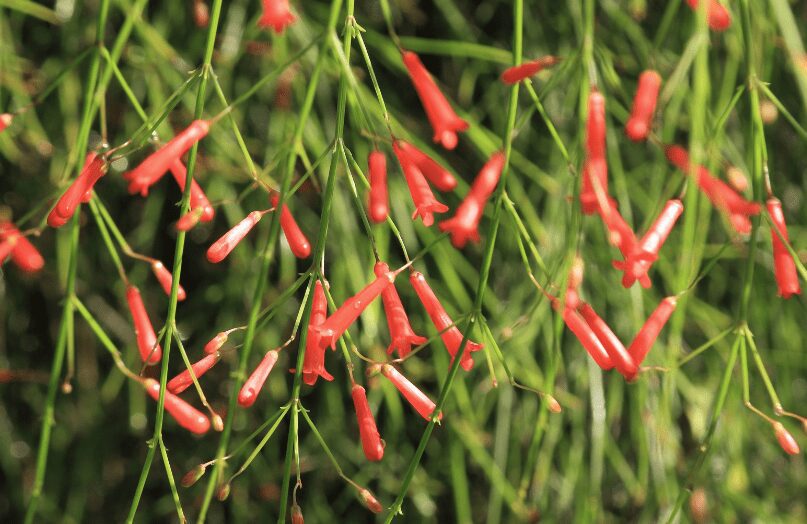
The firecracker plant is a popular perennial as it is easy to grow and needs little care. It is an herbaceous shrub growing 3 to 4 feet tall and has an arching growth habit.
The leaves are very narrow and small, which helps lend a soft and graceful look to the plant. Firecracker plant bears 1- to 2-inch long, tubular red flowers.
These are produced almost yearly, although they flower heaviest during the warmer months. Flowers are beautiful to hummingbirds.
Growing Firecracker Plant
Firecracker plant grows and flowers best in full sun. It is drought tolerant, has few pest problems, and is pretty salt tolerant. Cuttings are very quickly rooted, and often the stems that reach the ground will root at the tips to form new plants.
Firecracker plants can grow very thick, so for best appearances, cut it back in the early spring and remove the dead growth. It is fast growing and will quickly put forth new, attractive growth.
- Growth habit: An upright, rounded shrub with gradually arching branches growing to 5 feet tall and wide.
There are usually no leaves or only a few green bracts, but the stems are bright green and leaflike.
- Light: Flowering and growth are best in full sun, but it also tolerates some light shade.
- Water needs: Adaptable to drought. New plantings should be watered until their roots penetrate the soil. After that, seasonal rains usually provide adequate moisture.
- Feedings: To encourage growth, apply a general garden fertilizer once a month in March and June. As directed on the labels, slow-release fertilizers may be substituted.
- Propagation: Plants can be started by dividing old clumps or rooting tip cuttings.
- Ease of culture: Easy.
- Major problems: Mealybugs. To avoid this pest, plant in soils free of nematodes. Mealybugs are sporadic pests, but they are rarely a problem.
- Pruning: Firecracker plantings can grow quickly if given enough rain and fertilizer.
To keep them in check, give them plenty of room to grow and cut back as necessary. Make plans to prune in the late winter to eliminate dying stems. Regeneration pruning is required every few years to decrease the height and width.
- Uses: A drought-tolerant shrub that can be used in local settings as a unique and vibrant backdrop or border planting.
The thin green stalks swiftly transform into colorful spikes that open tubular crimson blooms for year-round displays that draw butterflies and hummingbirds.
Plantings are ideal for water-wise gardening and can be used as foundation and accent plantings or displayed in containers on a sunny patio.
Colorful Cultivars
Aureus’ has a light, creamy yellow flowers. ‘Flamingo Park’ bears light pink flowers. The coral blow plant, Russelia sarmentosa, is a related species that is similar.
It has larger ovate leaves and a darker green color. It also bears red flowers during the year.
Firecracker Plant Profile
- Firecracker Plant Specs
- Botanical name: Russelia equisetiformis
- Common name: Firecracker plant
- Origin: Southern Mexico
- Growth Habit: Herbaceous shrub with arching growth habit; grows 3 to 4 feet tall.
- Aesthetics/Characteristics: Slender, rush-like stems arch and hang to the ground; leaves are minimal and narrow, giving the plant a graceful look; bears red tubular flowers 1 to 2 inches long all year
- Hardiness: Zones 9-11
- Landscape Use: Good for use in masses, as a groundcover, or to attract butterflies and hummingbirds. It’s also helpful in containers, planters, or hanging baskets.






















